Chicago Part 1
The "New York" of the Midwest
Thursday 1st July
We flew into Chicago late afternoon. It is a four hour non-stop flight from LA. From the airport, we caught the train into the city - there were trains every 10-15 minutes to/from the airport!
Once checked into the hotel we realised there was plenty of daylight remaining to start exploring and with dinner in mind caught a train north to the area known as the Magnificent Mile - a section of Michigan Avenue lined with shops and beautiful buildings. We were a couple of blocks inland from Michigan Avenue and soon found our destination - "Pizzeria Uno" - the first deep dish pizza restaurant in North America. It opened in 1943 and had an old, somewhat British Pub/Restaurant look to it - outdoor tables, dark wooden interior, crowded. We noticed the crowd outside waiting for seats and so went in and were told it would be a 45 minute wait for a table, and they took our order. So, we decided to explore.
We didn't have to wait long for our table after returning to Pizzeria Uno. Whilst waiting for our pizza to arrive we read about the Restaurant's history on the wall - there were many framed posters. The pizza was definitely worth the wait - tall crush (deep dish, 4cm), about 20cm in diameter, and the filling (Jo had sausage and mushroom, and Rob had Cheese & Tomato) was intermingled in heaps of gooey creamy cheese. The crust was nearly like what you'd expect on a quiche. It was just amazingly good. We shared half of each pizza. Very satisfied, we walked across to Michigan Avenue and wandered down looking at the buildings.
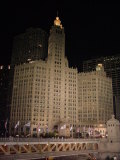
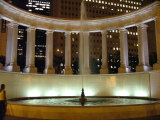
It was pleasantly warm, even though the sun had long set. We reached the Chicago river and immediately Rob recognised it as being what he'd seen in Hai-Tan's photos, taken on his visit last October. The river has bridges across it at each block, and along the side of the river we could see another street level below the streets along the river, and noticed some bridges were double level allowing traffic on the lower level to cross to streets below on the other side. We walked over the river and down to the area where the Millenium Park had been built. We admired the buildings all lit up at night. We came across a section of the park (Quick explanation - south of the river, ie near downtown, most of the land between Michigan Avenue and the Lake is parkland - Grant Park, Millenium Park, Museums, etc) where the "Family Album" exhibition had been setup.
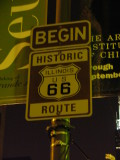
We spent some time wandering around reading the description of each family where they were from and admiring the portraits. They were all over the world, and they allo looked happy to be able to dress in their best clothes and stand, sometimes near their house, other times just against a whilte background. The photographer had done an excellent job at capturing the moment. The photos conveyed genuine joy in life, irrespective or circumstances. The photographer had asked each family about their history, aspirations, and it was a fascinating read. You can get the book "1000 Families: The Family Album of Planet Earth" by Uwe Ommer from
Amazon, or good bookstores.
Friday 2nd July
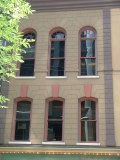
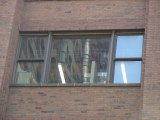
It's one thing to see the buildings, it's another to understand their history, engineering and how they show the development of the skyscrapers.We went on the "Historic Skyscrapers" walk by the
Chicago Architecture Foundation. We spent two hours with a volunteer guide walking around Chicago looking at the Historic Skyscrapers. Our guide explained the history of selected buildings, pointed out particular architecture features which had enabled the buildings to be used and enjoyed and sold to prospective owners/tennants. She talked about how the engineers were able to design tall buildings and how the technology of tall buildings changed over the early skyscraper period (18xx to 19xx). Initially tall bulidings (in the 6 to 12 story range) were constructed from brick and stone and all of the weight was borne by the outer walls and so the walls at the bottom could be 6ft (2m) thick, and they became thinner further up the building. The revolution came with steel framed buildings with the steel being so much stronger and lighter than brick and able to support the buildling's weight without being 6ft thick at the bottom.The buildings were also lighter and so the lower stories did not have to support as great a weight. Also the central core of the buliding around the elevator shaft was being used to provide strength and support. One of the challenges for tall buliding architechs was how to provide adequate natural light into each office, because electric light was in its infancy and provided inadequate brightness. Some buildings had an empty central core which allowed natural light into rooms not on the outside of the building. What is know as the "Chicago Window" was designed - a single centre pane with two narrower (maybe half width of the central pane) panes - one on each end which could be opened. It provided lots of light, and ventilation. It, however, required that all the buliding support be provided by the walls on each side of the window, which, until stell was being used extensively, required thicker walls.
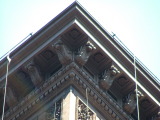
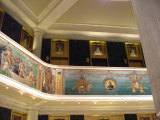
We saw different decorative features, including terracotta, stone work, subtle curving of brickwork, the design of the building to make it appear like a Grecian Column, glasswork, shining steel and alumninium. We went into a number of building lobbies - the Marquette Building to admire the Tiffany Glass, the brass elevator doors, the feeling of having entered a grand and expensive building, which was what the building's architect wanted as the building was speculative - ie built to be sold/leased to yet to be found companies.
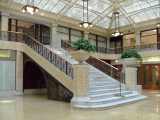
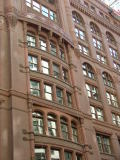
We looked in the lobby of Rookery Building which was redesigned by Frank Lloyd Wright. The lobby was in the centre of the building and the building was hollow in the centre to allow natural light into internal offices, and into the lobby through its glass ceiling. There was decorative gold on the ceiling trusswork, a mosaic tiled floor, and wood panelling that was very "Frank Lloyd Wright".
As the building technology improved buildings were being built taller and taller. Planning regulations required that the building be stepped back at a certain height to reduce the feeling of being closed in at street level. Due to this regulation, many architects exphasied the front section, placing distinctive features at the top of the front section of the building. They also emphasised the height using vertical stripes or lines.
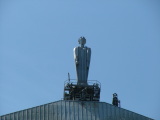
On top of the Chicago Board of Trade building, a sculpture of Ceres, Roman God of agriculture, was placed, and the sculptor thought the building to be so tall, that people would never be close enough, so did not put a face on the statue. From street level, this isn't immediatly obvious, but so many tall buildings are now close by and would see the statue quite well. Whilst admiring the Board of Trade we saw some men in the street in trading-floor jackets - those light weight waistcoasts with the huge numbers and patches showing who they worked for - the lok just like they do in the movies. The Board of Trade is where comodoties are traded - eg metals, grains, oil.
We looked, first at the outside and then the lobby, at the Field building, built in 1928-34 in the Art Deco Style. It was a very elegant building, designed to be tall (it was the tallest in Chicago for many years) and to look tall - lots of vertical lines, polished granite/marble, metal work, and that ultra modern look that was Art Deco. The lobby was large, and the vertical lines were used there too, in the elevator doors, even the mail box.
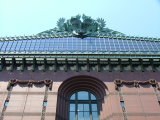
One of the last buildings we looked at was a bit of a trick - we thought it was old, but were told it had been built only recently but the architects had used many of the characterisits of the old buildings in its design. It was the new Chicago City Library - Harold Washington Library, and had huge thick walls at the bottom, it looked like a Grecian/Roman Column, and had huge copper decorations on its top corners.
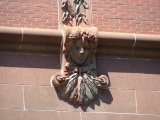
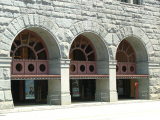
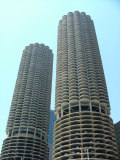
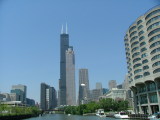
After the tour we returned to the Archicenter and after a look through their shop decided to go on an Architecture Cruise of the river. There were no bookings left on Saturday, but fortunately, some remaining for today, so we were soon rushing up Michigan Avenue to the boat dock, via a takeaway for a sandwich. And we thought the walking tour was good! The tour guilde (volunteer, no tips accepted, "just say hello and tell me where you are from") was amazing - during the 90 minute tour she sometimes took a break for a drink when we went under a bridge, but other than that talked the whole time telling us the name, architect, date and other information about every single building we passed. And all from memory. We were amazed. The tour covered the three arms of the Chicago river in the heart of Chicago. We were amazed at all the bridges, the buildings so close to the river's edge, the different styles and designs, and the continuing construction and renewal of all buildings. Many old warehouses have been, and some still are being, converted into office space and apartments.
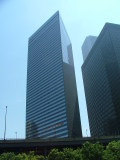
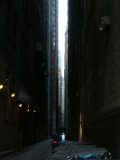
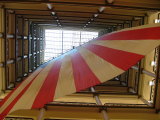
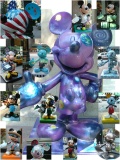
Once back on dry land, we wandered along state street where there were large Mickey Mouse statues, one or two per city block. They were being exhibited as part of Mickey Mouse's 75th Birthday/Anniversary. We managed to locate and photograph all but one of the statues (we were told later that this one was away being repaired). Each Mickey had been painted with a theme and the artwork was excellent at a distance and close up. We also visited Marshall Field's, where there was a 50x100 ft American Flag hanging in an atrium. This was billed as the World's largest flag inside a department store.
We went to the "Taste of Chicago" for dinner. We were looking forward to seeing how it compared to the most wonderful "Taste of Tasmania" which we have enjoyed many times in Hobart around New Year. Well, the "Taste of Chicago" was set up in Grant Park and seemed like half a kilometre end to end. We bought some tokens with which to exchange for food - all stalls had a "Taste Portion" for two or so tokens, and then other foods for increasing numbers of tokens. We tried a taste of Catfish Nuggets, BBQ ribs, which we hadn't tried in the USA before (even though they are considered a staple food by some) - they were nice, a lot more meat than we expected, and the BBQ sauce was ok, and meatballs in a roll. For dessert we tried some of Eli's Cheesecake (a Chicago dessert sold around the country) - it was very yummy.
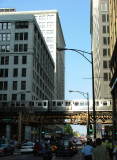
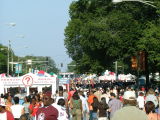
Grant Park was just swimming in people. At times the crowd seemed to just all stop, and yes, sometimes it was because people had stopped to eat! At different places around the periphery of the food stalls there was entertainment - live music (we saw jazz, gospel, rock), a diving pool with thin and tall towers from which the divers jumped. There was even a mini-theme park (midway rides) off one end.
A number of times we saw music groups playing on the street as we were walking around. Some were percussion groups, and whilst very loud (plug-your-ears loud) they were very good, and only used plastic buckets upside down as their drums. We also saw a big band and took a photo of them from across the street. Their lookouts were doing a good job and grabbed us as we crossed to them and asked us (and maybe more than asked) for a donation. However, they were selling a CD and it was a good price and good music, so we bought one.


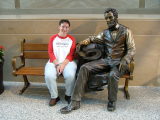
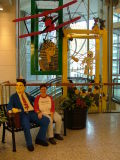
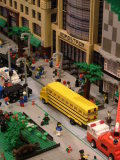 Jo had read about North Bridge, a Westfield Shopping center where there was a Lego Shop, and it was only a block away, so we went for a look. We were somewhat surprised it was still open and there were only a few people about, but the Lego was plentiful and there were some great models throughout the floor on which the Lego shop was. The Lego Shop had a great model of a section of the Magnificent Mile.
Jo had read about North Bridge, a Westfield Shopping center where there was a Lego Shop, and it was only a block away, so we went for a look. We were somewhat surprised it was still open and there were only a few people about, but the Lego was plentiful and there were some great models throughout the floor on which the Lego shop was. The Lego Shop had a great model of a section of the Magnificent Mile.
 It was pleasantly warm, even though the sun had long set. We reached the Chicago river and immediately Rob recognised it as being what he'd seen in Hai-Tan's photos, taken on his visit last October. The river has bridges across it at each block, and along the side of the river we could see another street level below the streets along the river, and noticed some bridges were double level allowing traffic on the lower level to cross to streets below on the other side. We walked over the river and down to the area where the Millenium Park had been built. We admired the buildings all lit up at night. We came across a section of the park (Quick explanation - south of the river, ie near downtown, most of the land between Michigan Avenue and the Lake is parkland - Grant Park, Millenium Park, Museums, etc) where the "Family Album" exhibition had been setup.
It was pleasantly warm, even though the sun had long set. We reached the Chicago river and immediately Rob recognised it as being what he'd seen in Hai-Tan's photos, taken on his visit last October. The river has bridges across it at each block, and along the side of the river we could see another street level below the streets along the river, and noticed some bridges were double level allowing traffic on the lower level to cross to streets below on the other side. We walked over the river and down to the area where the Millenium Park had been built. We admired the buildings all lit up at night. We came across a section of the park (Quick explanation - south of the river, ie near downtown, most of the land between Michigan Avenue and the Lake is parkland - Grant Park, Millenium Park, Museums, etc) where the "Family Album" exhibition had been setup.

 It's one thing to see the buildings, it's another to understand their history, engineering and how they show the development of the skyscrapers.We went on the "Historic Skyscrapers" walk by the Chicago Architecture Foundation. We spent two hours with a volunteer guide walking around Chicago looking at the Historic Skyscrapers. Our guide explained the history of selected buildings, pointed out particular architecture features which had enabled the buildings to be used and enjoyed and sold to prospective owners/tennants. She talked about how the engineers were able to design tall buildings and how the technology of tall buildings changed over the early skyscraper period (18xx to 19xx). Initially tall bulidings (in the 6 to 12 story range) were constructed from brick and stone and all of the weight was borne by the outer walls and so the walls at the bottom could be 6ft (2m) thick, and they became thinner further up the building. The revolution came with steel framed buildings with the steel being so much stronger and lighter than brick and able to support the buildling's weight without being 6ft thick at the bottom.The buildings were also lighter and so the lower stories did not have to support as great a weight. Also the central core of the buliding around the elevator shaft was being used to provide strength and support. One of the challenges for tall buliding architechs was how to provide adequate natural light into each office, because electric light was in its infancy and provided inadequate brightness. Some buildings had an empty central core which allowed natural light into rooms not on the outside of the building. What is know as the "Chicago Window" was designed - a single centre pane with two narrower (maybe half width of the central pane) panes - one on each end which could be opened. It provided lots of light, and ventilation. It, however, required that all the buliding support be provided by the walls on each side of the window, which, until stell was being used extensively, required thicker walls.
It's one thing to see the buildings, it's another to understand their history, engineering and how they show the development of the skyscrapers.We went on the "Historic Skyscrapers" walk by the Chicago Architecture Foundation. We spent two hours with a volunteer guide walking around Chicago looking at the Historic Skyscrapers. Our guide explained the history of selected buildings, pointed out particular architecture features which had enabled the buildings to be used and enjoyed and sold to prospective owners/tennants. She talked about how the engineers were able to design tall buildings and how the technology of tall buildings changed over the early skyscraper period (18xx to 19xx). Initially tall bulidings (in the 6 to 12 story range) were constructed from brick and stone and all of the weight was borne by the outer walls and so the walls at the bottom could be 6ft (2m) thick, and they became thinner further up the building. The revolution came with steel framed buildings with the steel being so much stronger and lighter than brick and able to support the buildling's weight without being 6ft thick at the bottom.The buildings were also lighter and so the lower stories did not have to support as great a weight. Also the central core of the buliding around the elevator shaft was being used to provide strength and support. One of the challenges for tall buliding architechs was how to provide adequate natural light into each office, because electric light was in its infancy and provided inadequate brightness. Some buildings had an empty central core which allowed natural light into rooms not on the outside of the building. What is know as the "Chicago Window" was designed - a single centre pane with two narrower (maybe half width of the central pane) panes - one on each end which could be opened. It provided lots of light, and ventilation. It, however, required that all the buliding support be provided by the walls on each side of the window, which, until stell was being used extensively, required thicker walls.
 We saw different decorative features, including terracotta, stone work, subtle curving of brickwork, the design of the building to make it appear like a Grecian Column, glasswork, shining steel and alumninium. We went into a number of building lobbies - the Marquette Building to admire the Tiffany Glass, the brass elevator doors, the feeling of having entered a grand and expensive building, which was what the building's architect wanted as the building was speculative - ie built to be sold/leased to yet to be found companies.
We saw different decorative features, including terracotta, stone work, subtle curving of brickwork, the design of the building to make it appear like a Grecian Column, glasswork, shining steel and alumninium. We went into a number of building lobbies - the Marquette Building to admire the Tiffany Glass, the brass elevator doors, the feeling of having entered a grand and expensive building, which was what the building's architect wanted as the building was speculative - ie built to be sold/leased to yet to be found companies.
 We looked in the lobby of Rookery Building which was redesigned by Frank Lloyd Wright. The lobby was in the centre of the building and the building was hollow in the centre to allow natural light into internal offices, and into the lobby through its glass ceiling. There was decorative gold on the ceiling trusswork, a mosaic tiled floor, and wood panelling that was very "Frank Lloyd Wright".
We looked in the lobby of Rookery Building which was redesigned by Frank Lloyd Wright. The lobby was in the centre of the building and the building was hollow in the centre to allow natural light into internal offices, and into the lobby through its glass ceiling. There was decorative gold on the ceiling trusswork, a mosaic tiled floor, and wood panelling that was very "Frank Lloyd Wright". On top of the Chicago Board of Trade building, a sculpture of Ceres, Roman God of agriculture, was placed, and the sculptor thought the building to be so tall, that people would never be close enough, so did not put a face on the statue. From street level, this isn't immediatly obvious, but so many tall buildings are now close by and would see the statue quite well. Whilst admiring the Board of Trade we saw some men in the street in trading-floor jackets - those light weight waistcoasts with the huge numbers and patches showing who they worked for - the lok just like they do in the movies. The Board of Trade is where comodoties are traded - eg metals, grains, oil.
On top of the Chicago Board of Trade building, a sculpture of Ceres, Roman God of agriculture, was placed, and the sculptor thought the building to be so tall, that people would never be close enough, so did not put a face on the statue. From street level, this isn't immediatly obvious, but so many tall buildings are now close by and would see the statue quite well. Whilst admiring the Board of Trade we saw some men in the street in trading-floor jackets - those light weight waistcoasts with the huge numbers and patches showing who they worked for - the lok just like they do in the movies. The Board of Trade is where comodoties are traded - eg metals, grains, oil. One of the last buildings we looked at was a bit of a trick - we thought it was old, but were told it had been built only recently but the architects had used many of the characterisits of the old buildings in its design. It was the new Chicago City Library - Harold Washington Library, and had huge thick walls at the bottom, it looked like a Grecian/Roman Column, and had huge copper decorations on its top corners.
One of the last buildings we looked at was a bit of a trick - we thought it was old, but were told it had been built only recently but the architects had used many of the characterisits of the old buildings in its design. It was the new Chicago City Library - Harold Washington Library, and had huge thick walls at the bottom, it looked like a Grecian/Roman Column, and had huge copper decorations on its top corners.
 After the tour we returned to the Archicenter and after a look through their shop decided to go on an Architecture Cruise of the river. There were no bookings left on Saturday, but fortunately, some remaining for today, so we were soon rushing up Michigan Avenue to the boat dock, via a takeaway for a sandwich. And we thought the walking tour was good! The tour guilde (volunteer, no tips accepted, "just say hello and tell me where you are from") was amazing - during the 90 minute tour she sometimes took a break for a drink when we went under a bridge, but other than that talked the whole time telling us the name, architect, date and other information about every single building we passed. And all from memory. We were amazed. The tour covered the three arms of the Chicago river in the heart of Chicago. We were amazed at all the bridges, the buildings so close to the river's edge, the different styles and designs, and the continuing construction and renewal of all buildings. Many old warehouses have been, and some still are being, converted into office space and apartments.
After the tour we returned to the Archicenter and after a look through their shop decided to go on an Architecture Cruise of the river. There were no bookings left on Saturday, but fortunately, some remaining for today, so we were soon rushing up Michigan Avenue to the boat dock, via a takeaway for a sandwich. And we thought the walking tour was good! The tour guilde (volunteer, no tips accepted, "just say hello and tell me where you are from") was amazing - during the 90 minute tour she sometimes took a break for a drink when we went under a bridge, but other than that talked the whole time telling us the name, architect, date and other information about every single building we passed. And all from memory. We were amazed. The tour covered the three arms of the Chicago river in the heart of Chicago. We were amazed at all the bridges, the buildings so close to the river's edge, the different styles and designs, and the continuing construction and renewal of all buildings. Many old warehouses have been, and some still are being, converted into office space and apartments.
 Once back on dry land, we wandered along state street where there were large Mickey Mouse statues, one or two per city block. They were being exhibited as part of Mickey Mouse's 75th Birthday/Anniversary. We managed to locate and photograph all but one of the statues (we were told later that this one was away being repaired). Each Mickey had been painted with a theme and the artwork was excellent at a distance and close up. We also visited Marshall Field's, where there was a 50x100 ft American Flag hanging in an atrium. This was billed as the World's largest flag inside a department store.
Once back on dry land, we wandered along state street where there were large Mickey Mouse statues, one or two per city block. They were being exhibited as part of Mickey Mouse's 75th Birthday/Anniversary. We managed to locate and photograph all but one of the statues (we were told later that this one was away being repaired). Each Mickey had been painted with a theme and the artwork was excellent at a distance and close up. We also visited Marshall Field's, where there was a 50x100 ft American Flag hanging in an atrium. This was billed as the World's largest flag inside a department store.